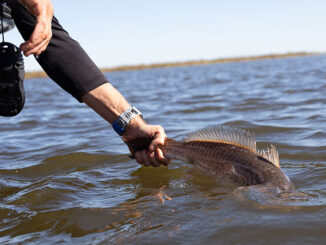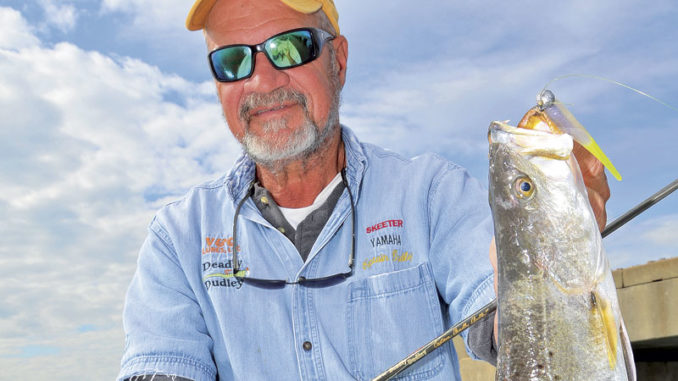
When it comes to some of the best fishing in Louisiana, “a bridge runs over it.”
Several bridges spanning Lake Pontchartrain create miles of artificial reefs that hold various fish species all year long, but action really heats up as temperatures drop and you can take advantage of these fish “traffic jams.”
“November on Lake Pontchartrain is an excellent time to fish,” said Mike Gallo of Angling Adventures of Louisiana (877-4AAOFLA, www.aaofla.com) in Slidell. “Heading into the wintertime, fish instinctively know that food is about to be scarce so they eat like pigs.”
Almost 25 miles long, the Lake Pontchartrain Causeway spans the widest part of the lake. With nearly 10,000 pilings supporting the longest bridge in the world running continuously over water, it resembles a concrete forest of fish-holding structures.
“The Causeway is a 25-mile reef,” quipped Andy Jones of Wicked Fishing Charters (985-750-0670, www.mandevillefishingcharters.com) in Mandeville. “Fishing in 2022 was incredible. We were catching many trout in the 16 to 20-inch range and quite a few over 20 inches.”
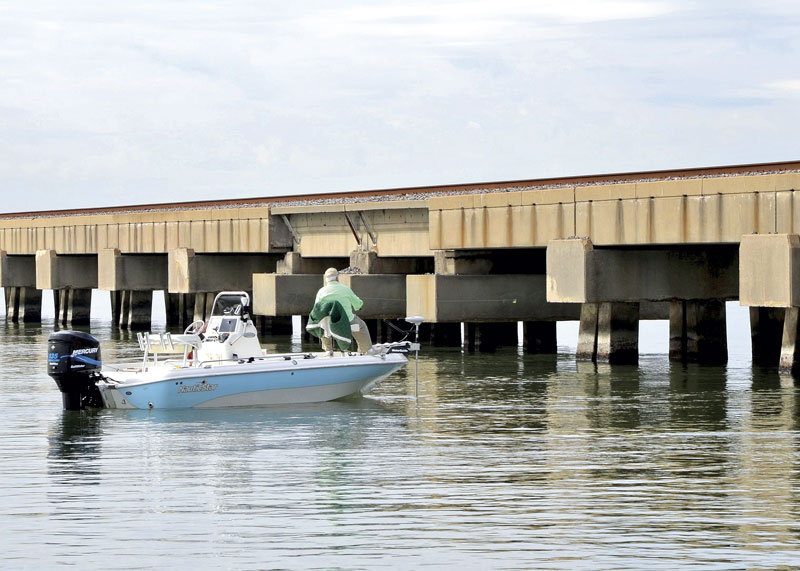
Fishing the bridges
Interstate 10, Highway 11 and a railroad trestle dating to 1884 cross the “Middle Grounds” from Slidell to New Orleans East. The Rigolets and Chef Menteur passes connect Lake Pontchartrain to Lake Borgne and ultimately the Gulf of Mexico. They bring good salty water to the eastern half of Lake Pontchartrain. Rail and vehicle bridges also cross the Rigolets and Chef. Any of these structures can produce outstanding action for speckled trout, redfish, sheepshead and many other species.
“I’ve been fishing those bridges since I was five years old,” said the 69-year-old Kenny Kreeger of Lake Pontchartrain Charters (985-960-3068, www.lakepontchartraincharters.com) in Slidell. “I’ve seen that train trestle change from creosote wooden pilings to concrete. I like to fish under I-10 in the summer to stay in the shade.”
In 2005, Hurricane Katrina severely damaged the original I-10 “Twin Bridges.” The new spans run parallel to the old bridge, but substantial structure from concrete slabs and other debris still attract fish where the old spans once stood. A portion of the old I-10 remains jutting out from the northern shoreline near Slidell.
Thousands of barnacle-encrusted pilings on each of these bridges provide excellent cover throughout the entire water column. Bottom debris accumulated over the centuries also hold fish. Tides washing around the pilings scour small doughnut-shaped depressions in the bottom that make great places for predators to ambush prey.
“I do a lot of fishing under the bridges,” Gallo said. “I circle the pilings with a depth finder to find structure on the bottom. Many huge concrete chunks have been on the lake bottom for years.”
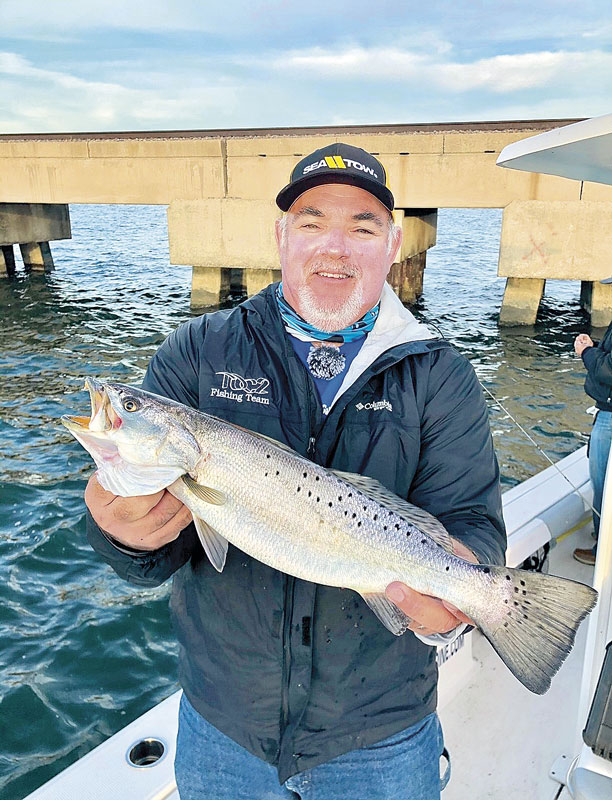
Speckled trout
In January 1999, Kreeger kicked off a run of giant speckled trout coming from the lake and associated waters. Kreeger’s fish and two others made the Louisiana record books.
On Super Bowl Sunday, Kreeger headed into the lake, despite temperatures hovering around 28 degrees with howling winds. Fishing next to Highway 11, Kreeger flipped a 3/8-ounce jighead sweetened with a queen-sized soft-plastic sparkle beetle toward the pilings and pulled up a speck weighing 11.99 pounds, the largest caught in Louisiana since 1950.
“Besides the big one, I caught five trout over six pounds, eight over five pounds and the rest over four pounds,” Kreeger said. “It’s been years since we’ve seen big ones like that, but the lake still holds a lot of good trout. Since they started blocking the waterways for hurricane protection, the water doesn’t get as salty.”
Nine months later, Jason Troullier yanked an 11.24-pounder from the Rigolets to take the No. 3 position in the record book. In April 2002, Dudley Vandenborre added a 10.50-pounder to the roster.
“All my big fish came off Highway 11,” said Vandenborre, (985-847-1924), a guide from Slidell. “Over the years, I’ve had my best success fishing the railroad trestle along the south shore. The trestle has way more fish than any other bridge, but most are smaller. Highway 11 has the biggest trout, but not as many.”
Many trout fishermen work the pilings like bass anglers fishing flooded timber. They cruise along slowly with their trolling motors, hitting every piling from multiple angles with various baits. Drop temptations as close to the pilings as possible.
“We use a technique that Chas Champagne calls ‘the Pontchartrain Pop,’” Jones said. “We cast a jig as close to the pilings as possible and let it hit bottom. Then, we pop it up and down two or three times in that same spot. Sometimes, the bite will be very subtle so we watch the line for movement. Often, a fish will just suck in a bait. An inexperienced angler might never feel the bite.”
Work slower, deeper
As water cools, work baits slower and deeper. Pause occasionally to let it sink. Fish normally strike as a bait falls, resembling dying prey. When the bite gets tough, switch to lighter fluorocarbon lines that virtually disappear in the water.
“When I’m looking for trout in November, I look for deep water,” Gallo said. “When the temperature drops to about 57 to 54 degrees, fish hang a bit deeper, usually in the 6 to 10-foot range.”
Jones frequently trolls along the bridges. He’ll run baits along either side of the spans and sometimes between twin spans. Trolling makes a great way to search for fish and allow children to catch big ones. When trolling, youngsters don’t need to worry about casting or hooking fish.
“I troll with MirrOlure MirrOlip or a ½ to ¾-ounce Rat-L-Trap,” Jones said. “The farther back we fish those lures, the deeper they dive. I run two rods at different lengths off the T-top. I also run two lead lines on shorter rods straight off the back. I run one just barely off the bottom and one a couple feet higher. Once we determine where fish want to stay, we set everything to that and have a great time.”
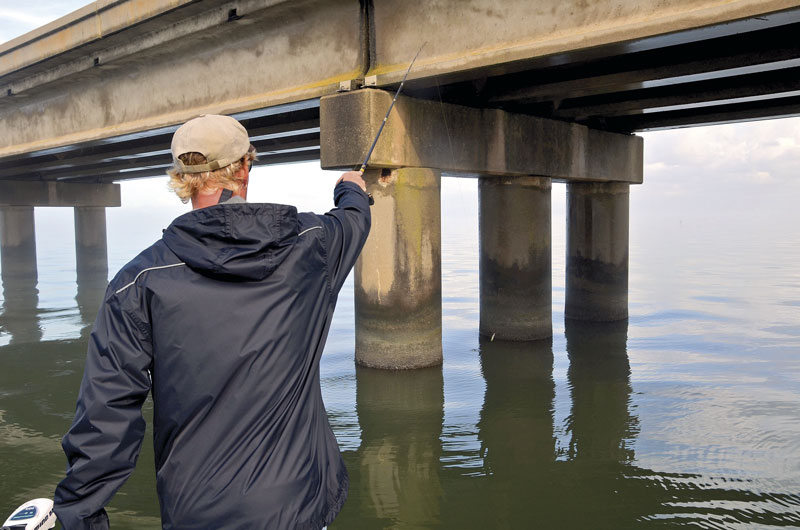
Fishing success along the Causeway largely depends upon the Bonnet Carré Spillway near Norco. When the Mississippi River threatens to flood New Orleans, the U.S. Army Corps of Engineers opens the gates to divert water into Lake Pontchartrain. The opening on the lake side points directly at Mandeville, but affects the entire estuary. Since 2011, the spillway opened six times, most recently in 2020. The massive influx of fresh water displaces salty species, but fishing improves once the lake returns to normal.
“A few months after the last spillway opening, fishing was absolutely dynamite,” Jones said. “We started seeing shrimp again. A spillway opening brings in a lot of nutrients. That’s good for the lake in the long run. In 2022, we caught some the biggest striped bass off the Causeway that I’ve ever seen.”
Blue catfish
All that fresh water flowing into the estuary probably contributed to a freshwater catfish population boom. The western end of the lake remains the freshest. Highly tolerant of salinity, blue catfish might appear anywhere in the lake. Most blues average about two to eight pounds, but some exceed 30 pounds.
“We see a lot more catfish every year,” Kreeger said. “We always catch one or two in the summer. In the winter, when the water temperature drops below 50, we see many blue cats in the lake. In the winter of 2021-22, we had a pretty good cat run. Catfish act just like redfish. I’ll throw out a couple handfuls of shrimp heads or fish pieces for chum and put out four rods baited with shrimp.”
Redfish
Anglers might catch redfish by the bridges all year long, but marshes nearly surrounding Lake Pontchartrain hold great populations of redfish and flounder. Between the Rigolets and the Mississippi state line, Pearl River feeds a fertile delta marsh loaded with redfish.
In late summer and fall, giant bull reds migrate in from the Gulf of Mexico through Lake Borgne and the passes. Anglers regularly see huge schools terrorizing baitfish in the Middle Grounds.
“In November, we watch for birds diving on huge white shrimp,” Gallo said. “Bull reds chase the shrimp. I always try to talk to shrimpers because where shrimp go, fish go. It’s always fun to catch a bull red, snap a few pictures and release it. The passes bringing water to and from Lake Pontchartrain can be highly productive. The old railroad bridge over the Rigolets is always productive.”
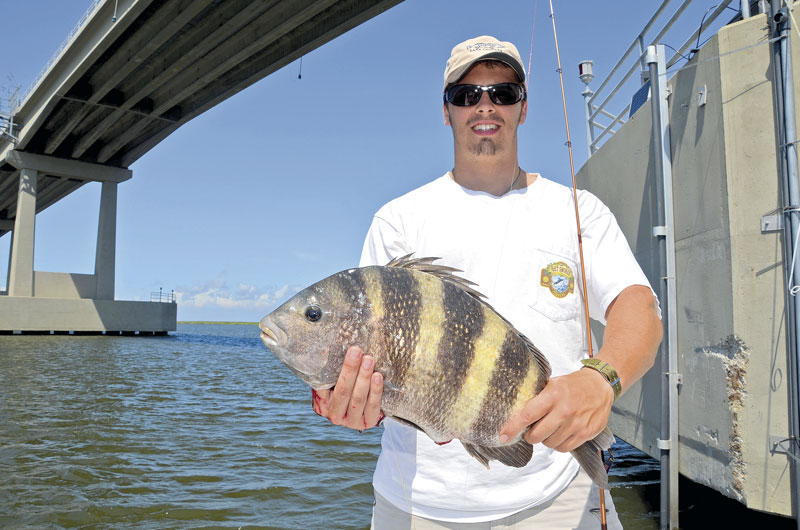
Other species
Sheepshead love to nibble barnacles off hard structures. Besides the bridges, the state established several artificial reefs throughout the lake, some made with old bridge spans knocked down by hurricanes. With so many structures, Lake Pontchartrain offers some of the best sheepshead fishing in the world. In fact, the world record, a 21.25-pounder came from where Bayou St. John in New Orleans flows into Lake Pontchartrain.
The lake can also provide good action on many other species like black drum, white trout and croakers. At times, big sharks, tripletail and jack crevalle move into the estuary. While heading elsewhere, many anglers drive over giant fish just below them lurking around bridge pilings.
For help planning a trip, contact the St. Tammany Parish Tourist and Convention Commission at 800-634-9443. On line, see www.LouisianaNorthshore.com.

Bridges: Fish cover that neither you nor the fish can miss
Most people fish the bridges spanning Lake Pontchartrain because these concrete structures provide abundant cover for many species. Keep these bridges in mind when you need a place to go:
- Causeway — The parallel Causeway spans stretch 24 miles across the widest part of Lake Pontchartrain. The first span opened in 1956, followed by the second span in 1969.
- Interstate-10 — In 2005, Hurricane Katrina severely damaged the original “Twin Bridges” crossing eastern Lake Pontchartrain. One new 5.5-mile-long span opened in 2009 parallel to the old bridge. A second span opened in 2010. The remains of the old 1965 bridges were demolished and removed with some bridge rubble used to create artificial reefs. Part of the original twin spans remains as a fishing pier on the Slidell side of the lake.
- U.S Highway 11 — Officially 4.78 miles long, the “Five-Mile” Bridge opened in 1928 as the Maestri Bridge, named for a former New Orleans mayor. Now it’s formally called the Watson-Williams Pontchartrain Bridge.
- Others — The original wooden railroad trestle dated to 1884. More recently, a concrete bridge replaced the old wooden structure near Highway 11. Another railroad crosses both the Chef Menteur and the Rigolets passes near Lake Borgne. In 2008, a new U.S. Highway 90 bridge opened to replace a 1930 bridge that once crossed the Rigolets near Lake Pontchartrain. A 1930 car bridge still crosses the Chef.

